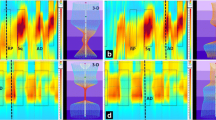Abstract
Background
The sampling reflex is necessary to begin defecation or flatulence. It consists of a simultaneous rectoanal inhibitory reflex (RAIR) mediated by relaxation of the internal anal sphincter and rectoanal excitatory reflex (RAER) mediated by contraction of the external anal sphincter. The aim of this study was to evaluate the sampling reflex in patients with functional defecation disorder (FDD).
Methods
A prospective cohort study was conducted on 58 obstructed defecation syndrome (ODS) patients with FDD. All 58 patients and 20 controls were evaluated with anorectal manometry to study the sampling reflex. Quantitative RAIR (total duration of reflex; maximal amplitude of relaxation; residual pressure at the lowest point of the RAIR) and RAER data (maximal amplitude of contraction; duration) were obtained. The straining test on manometry was considered positive for FDD if there was a muscle contraction/lack of relaxation or an insufficient pressure gradient for the passage of feces. Defecography was performed on all the patients with assessment of the anorectal angle and persistence or increase of puborectalis indentation.
Results
Fifty (86.2%) FDD patients had an altered sampling reflex, showing incomplete/short duration of RAIR and excessive contraction/duration of RAER. More specifically, there was a correlation between a positive straining test and a short total duration of RAIR (ρ 0.92) as well as with excessive duration of RAER (ρ 0.89). There was also a correlation between lack of muscle relaxation on defecography and short total duration of RAIR ((ρ 0.79) and between lack of muscle relaxation on defecography and excessive duration of RAER (ρ 0.83). Altered maximal amplitude relaxation had the highest sensitivity in detecting impairment of RAIR (87.9) while maximal amplitude contraction had the highest sensitivity in detecting impairment of RAER (89.6). High residual pressure at the lowest point of RAIR had the highest specificity in detecting impairment of RAIR (80.0) while RAER duration had the highest specificity in detecting impairment of RAER (77.7).
Conclusion
The sampling reflex is impaired in patients with FDD. This finding provides an important insight into the pathogenesis of obstructed functional defecation.




Similar content being viewed by others
References
Bajwa A, Emmanuel A (2009) The physiology of continence and evacuation. Best Pract Res Clin Gastroenterol 23:477–485
Zbar AP, Aslam M, Gold DM et al (1998) Parameters of the rectoanal inhibitory reflex in patients with idiopathic fecal incontinence and chronic constipation. Dis Colon Rectum 41:200–208
Ornö AK, Marsál K (2006) Sonographic investigation of the rectoanal inhibitory reflex: a qualitative pilot study in healthy females. Dis Colon Rectum 49:233–237
Broens P, Vanbeckevoort D, Bellon E, Penninckx F (2002) Combined radiologic and manometric study of rectal filling sensation. Dis Colon Rectum 45:1016–1022
Duthie HL, Bennett RC (1963) The relation of sensation in the anal canal to the functional anal sphincter: a possible factor in anal continence. Gut 4:179–182
Rao SSC, Bharucha AE, Chiarioni G et al (2016) Anorectal disorders. Gastroenterology 150:1430–1442
Bordeianou LG, Carmichael JC, Paquette IM et al (2018) Consensus statement of definitions for anorectal physiology testing and pelvic floor terminology (revised). Dis Colon Rectum 6:421–427
O’Donnell LJ, Virjee J, Heaton KW (1988) Pseudo-diarrhoea in the irritable bowel syndrome: patients records of stool form reflect transit time while stool frequency does not. Gut 29:A1455
Mearin F, Lacy BE, Chang L et al (2016) Bowel disorders. Gastroenterology S0016–5085(16):00222–00225. https://doi.org/10.1053/j.gastro.2016.02.031
Altomare DF, Spazzafumo L, Rinaldi M et al (2008) Set-up and statistical validation of a new scoring system for obstructed defaecation syndrome. Colorectal Dis 10:84–88
Piloni V, Genovesi N, Grassi R et al (1993) National working team report on defecography. Radiol Med 85:784–793
Pucciani F, Boni D, Perna F et al (2005) Descending perineum syndrome: are abdominal hysterectomy and bowel habits linked? Dis Colon Rectum 48:2094–2099
Bossuyt PM, Reitsma JB, Bruns DE et al (2015) STARD 2015: an updated test of essential items for reporting diagnostic accuracy studies. BMJ 35:h5527
Pucciani F (2020) Anorectal functional anatomy, in High resolution and high definition anorectal manometry (eds) M. Bellini. Springer. Cham 1–10
Bocchini R, Chiarioni G, Corazziari E, Pucciani F et al (2019) Pelvic floor rehabilitation for defecation disorders. Tech Coloproct 23:101–115
Pucciani F, Rottoli ML, Bologna A et al (1998) Pelvic floor dyssynergia and bimodal rehabilitation: results of combined pelviperineal kinesitherapy and biofeedback training. Int J Colorectal Dis 13:124–130
Pucciani F, Rottoli ML, Bologna A et al (1996) Anterior rectocele and anorectal dysfunction. Int J Colorect Dis 11:1–9
Pucciani F (2007) Rectal prolapse: pathophysiology, in Rectal prolapse: Diagnosis and clinical management (eds) D.F. Altomare, and F Pucciani. Springer. Milan 13–19
Sun WM, Read NW, Shorthouse AJ (1990) Hypertensive anal cushions as a cause of the high anal canal pressures in patients with haemorrhoids. Br J Surg 77:458–462
Vyslouzil K, Zboril P, Skalicky P, Vomackova K (2010) Effect of hemorrhoidectomy on anorectal physiology. Int J Colorectal Dis 25:259–265
Kaur G, Gardiner A, Duthie G (2012) Rectoanal reflex parameters in incontinence and constipations. Dis Colon Rectum 45:928–933
Thiruppathy K, Mason J, Akbari K, Raeburn A, Emmanuel A (2017) Physiological study of the anorectal reflex in patients with functional anorectal and defecation disorders. J Dig Dis 18:222–228
Broens P, Penninckx FM, Ochoa JB (2013) Fecal continence revisited: the anal external sphincter continence reflex. Dis Colon Rectum 56:1273–1281
Sangwan YP, Coller JA, Barrett RC et al (1995) Distal rectoanal excitatory reflex: a reliable index of pudendal neuropathy? Dis Colon Rectum 38:916–920
Lee TH, Bharucha AE (2016) How to perform and interpret a high-resolution anorectal manometry test. J Neurogastroenterol Motil 22:46–59
Author information
Authors and Affiliations
Corresponding author
Ethics declarations
Conflict of interest
No potential and real conflict of interest.
Additional information
Publisher's Note
Springer Nature remains neutral with regard to jurisdictional claims in published maps and institutional affiliations.
Rights and permissions
About this article
Cite this article
Pucciani, F., Trafeli, M. Sampling reflex: pathogenic role in functional defecation disorder. Tech Coloproctol 25, 521–530 (2021). https://doi.org/10.1007/s10151-020-02393-5
Received:
Accepted:
Published:
Issue Date:
DOI: https://doi.org/10.1007/s10151-020-02393-5




